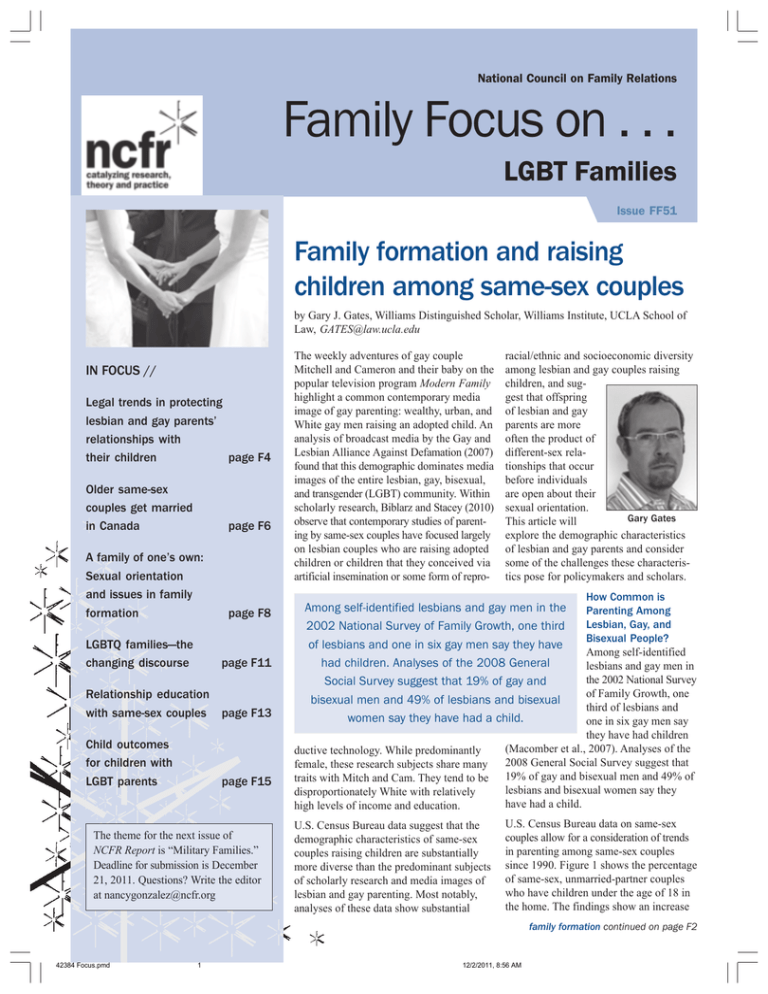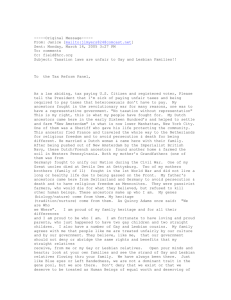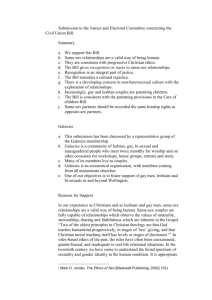
National Council on Family Relations
Family Focus on . . .
LGBT Families
Issue FF51
IN FOCUS //
Reflections on
intergenerational relations
page F3
Who gets custody of
Grandma after the divorce?
page F5
The many faces of parental
estrangement
page F8
IN
FOCUS // cultural
Intergenerational
bonds: A look at
Legal trends in protecting
Ukranian-American families page F11
lesbian and gay parents’
Building
intergenerational
relationships
with
relationships
via an Elder
their children
page F4
Service Partner program
page F13
Older same-sex
Family stress and risk in
couples get married
grandparent-headed
in Canada
page F6
households
page F14
A family of one’s own:
Sexual orientation
and issues in family
formation
LGBTQ families—the
changing discourse
page F8
page F11
Relationship education
with same-sex couples page F13
Child outcomes
for children with
LGBT parents
page F15
The theme for the next issue of
NCFR Report is “Military Families.”
Deadline for submission is December
21, 2011. Questions? Write the editor
at nancygonzalez@ncfr.org
Family formation and raising
children among same-sex couples
by Gary J. Gates, Williams Distinguished Scholar, Williams Institute, UCLA School of
Law, GATES@law.ucla.edu
The weekly adventures of gay couple
Mitchell and Cameron and their baby on the
popular television program Modern Family
highlight a common contemporary media
image of gay parenting: wealthy, urban, and
White gay men raising an adopted child. An
analysis of broadcast media by the Gay and
Lesbian Alliance Against Defamation (2007)
found that this demographic dominates media
images of the entire lesbian, gay, bisexual,
and transgender (LGBT) community. Within
scholarly research, Biblarz and Stacey (2010)
observe that contemporary studies of parenting by same-sex couples have focused largely
on lesbian couples who are raising adopted
children or children that they conceived via
artificial insemination or some form of repro-
racial/ethnic and socioeconomic diversity
among lesbian and gay couples raising
children, and suggest that offspring
of lesbian and gay
parents are more
often the product of
different-sex relationships that occur
before individuals
are open about their
sexual orientation.
Gary Gates
This article will
explore the demographic characteristics
of lesbian and gay parents and consider
some of the challenges these characteristics pose for policymakers and scholars.
ductive technology. While predominantly
female, these research subjects share many
traits with Mitch and Cam. They tend to be
disproportionately White with relatively
high levels of income and education.
How Common is
Parenting Among
Lesbian, Gay, and
Bisexual People?
Among self-identified
lesbians and gay men in
the 2002 National Survey
of Family Growth, one
third of lesbians and
one in six gay men say
they have had children
(Macomber et al., 2007). Analyses of the
2008 General Social Survey suggest that
19% of gay and bisexual men and 49% of
lesbians and bisexual women say they
have had a child.
U.S. Census Bureau data suggest that the
demographic characteristics of same-sex
couples raising children are substantially
more diverse than the predominant subjects
of scholarly research and media images of
lesbian and gay parenting. Most notably,
analyses of these data show substantial
U.S. Census Bureau data on same-sex
couples allow for a consideration of trends
in parenting among same-sex couples
since 1990. Figure 1 shows the percentage
of same-sex, unmarried-partner couples
who have children under the age of 18 in
the home. The findings show an increase
Among self-identified lesbians and gay men in the
2002 National Survey of Family Growth, one third
of lesbians and one in six gay men say they have
had children. Analyses of the 2008 General
Social Survey suggest that 19% of gay and
bisexual men and 49% of lesbians and bisexual
women say they have had a child.
family formation continued on page F2
42384 Focus.pmd
1
12/2/2011, 8:56 AM
Family Focus on...
LGBT Families
family formation continued from page F1
in childrearing from 12% of couples in 1990
to nearly 19% of couples in 2006. Since
then, the percentage of such couples raising
children has declined to 16%. This pattern
seems to contradict the prevailing view that
increasing numbers of lesbians and gay men
(and same-sex couples) are raising children.
However, a closer look at these data sug-
adoptive parenting and parenting using
reproductive technologies. This could explain the overall reduced number of samesex couples who have children.
Several data sources offer evidence that a
common path to parenthood for LGB men and
women is a relationship with a different-sex
partner when they are young. First, data
Figure 1. % of same-sex unmarried partner couples with children under the age of 18 in the home*
*Author analyses of Public Use Microdate Files: 1990 Census, 2000 Census, 2005-2009 American Community Survey.
For comparability purposes, analyses only include same-sex couples who identified one partner as an “unmarried partner.”
Couples who designated a partner as a “husband” or “wife” are not included.
gests that there may be two different trends
occurring with regard to parenting.
How Do Lesbian, Gay, and Bisexual
People Come to Be Parents?
In the 2000 U.S. Census, nearly 10% of the
same-sex, unmarried-partner couples raising
children were in households with an adopted
child present. By 2009, American Community
Survey (ACS) data suggest that the comparable figure had nearly doubled to 19%.
Clearly, the decade saw a substantial rise
in adoptive parenting by same-sex couples.
Nevertheless, those increases may have
been offset by decreases in parenting by
lesbian, gay, and bisexual (LGB) individuals who had children at a relatively young
age (likely before they were open about or
aware of their same-sex sexual orientation)
in a relationship with a different-sex partner.
Declines in social stigma toward LGB people
mean that more are coming out earlier in
life and are becoming less likely to have
children with different-sex partners. These
declines may be outpacing increases in
was born. For lesbians and bisexual women,
the figure was 37.9%; this difference was
statistically significant (p < .05).
Second, the characteristics of same-sex
couples raising children, as observed in the
ACS, are consistent with patterns one might
expect if many LGB people were bringing up
children from prior different-sex relationships. In the 2009 data, 28% of individuals
in same-sex couples who were previously
married (presumably to a different-sex partner) had children under age 18 in the home,
compared to just 16% of those who said
they had never been married. Among those
in same-sex couples who were previously
married, 23.5% report a biological or stepchild in the home, compared to just 9.5%
among those who never married. Conversely,
among never-married individuals in samesex couples who report children in the home,
22.6% say that at least one of the children is
adopted. Among their previously married
counterparts, the figure is half that at 11.5%.
Notably, the average age of adopted children
living with same-sex couples is nearly 4
years younger than that of biological or
stepchildren (8.3 vs. 12.4 years old). This is
evidence that individuals in same-sex couples
who were previously married are much more
likely to have biological or stepchildren
(perhaps from a previous marriage), while
from population-based surveys suggest that
family formation continued on page F3
LGB individuals are younger than non–LGB
individuals when they
have their first child. In
the 2008 General Social
Survey, the average age
of LGB respondents
when they had or gave
birth to their first child
was 22.5 years. Among
heterosexuals, the average age was older, at
24.1 years (although the
difference was not
statistically significant).
A similar pattern is
observed for women in
the 2009 California
Health Interview Survey.
Among women who have
had a child, 22.4% of
heterosexual women said
they were under age 20
Table 1. Regions ranked by % of same-sex couples with children under age 18 in the
when their first child
home (American Community Survey, 2005-2009)
F2
42384 Focus.pmd
family focus // winter 2011
2
12/2/2011, 8:56 AM
Family Focus on...
LGBT Families
family formation continued from page F2
those were never married are more likely to raising children.
have adopted children (perhaps later in life). The comparable
figures for Latinos
What are the Demographic Characteristics
and Latinas and
of Same-Sex Couples with Children?
American Indians/
Geographically, same-sex couples are most
Alaska Natives in
likely to have children in many of the most
different-sex
socially conservative parts of the country.
Analyses of ACS data from 2005–2009 (see couples are 1.7 and
1.3, respectively.
Table 1) show that same-sex parenting is
more common in the South, where more
than 26% of same-sex couples are raising
children, than in more socially liberal regions like New England (24%) or the Pacific states (21%).
Among individuals in same-sex couples,
childrearing is substantially higher among
African-American, Latino, and Native
American/Alaskan natives (see Figure 2).
This is also true for different-sex couples,
but the relative differences between rates of
White and African-American parenting, in
particular, are greater among individuals in
same-sex couples. African-Americans in
same-sex couples are 2.4 times more likely
than their White counterparts to be raising
children (40% v. 16%, respectively). Latinos
and Latinas (28%) in same-sex couples are
1.7 times more likely than Whites to be
raising children, and American Indians/Alaska
Natives (24%) are 1.5 times more likely. For
different-sex couples, African-Americans are
only 1.3 times more likely than Whites to be
Figure 3. % of individuals in couples with children under age 18 in the home, by
educational attainment (American Community Survey, 2009)
The pattern is the
opposite when we
consider adoptive
parenting. White
same-sex couples
with children are
almost twice as
likely as same-sex
couples with a non-White partner to be
raising an adopted child. Among White
same-sex couples with children, 18%
report having an adopted child, compared
to 9.6% of comparable couples that include
a non-White partner.
Childrearing among same-sex couples is
also substantially more common among
those with lower levels of education.
Among individuals in same-sex couples
who have less than a high school degree,
43% are raising children. Only 15% percent
of those with a graduate degree have children. This pattern is not true in different-sex
couples, where between 41% and 48% are
Figure 2. % of individuals in couples with children under age 18 in the home, by race/ethnicity (American
Community Survey, 2009)
raising children, regardless of their educational attainment.
As with observed racial/ethnic differences
in childrearing, the pattern is the opposite
with regard to adoptive parenting. Among
individuals in same-sex couples who are
raising children, education is clearly correlated with the likelihood of having an
adopted child in the home. Among those
with a high school diploma or lower levels
of educational attainment, less than 8% have
an adopted child. For college graduates, the
comparable figure is 18% and among those
with a graduate degree, fully one third have
an adopted child.
Given the connections between parenting
and education, it is perhaps not surprising
that same-sex couples with children show
evidence of economic disadvantage relative
to their different-sex counterparts. In analyses
of data from the 2000 U.S. Census, Albelda
and colleagues (2009) show that 20% of
children being raised by same-sex couples
are living in poverty compared to only 9.4%
of children being raised by different-sex
married couples.
What Do These Patterns Regarding LGB
Parenting Mean?
The available data garnered from populationbased sources demonstrate unique dynamics
of race, ethnicity, socioeconomic status,
geography, gender, and sexual orientation
that intersect and interact to affect how LGB
people come to be parents and what types of
legal and economic resources they may have
family formation continued on page F4
family focus // winter 2011
42384 Focus.pmd
F3
3
12/2/2011, 8:56 AM
Family Focus on...
LGBT Families
Legal trends in protecting lesbian and
gay parents’ relationships with their children
by Tara Borelli and Beth Littrell, TBorelli@lambdalegal.org
With an increasing number of states recognizing same-sex relationships and recent
court victories striking down discriminatory
adoption laws, the gay community is making
critically needed progress in securing legal
relationships between lesbian and gay parents
and their children. Nevertheless, significant
challenges remain, and far too many lesbians
and gay men must live with laws that leave
their parent–child relationships inadequately
protected. As the legal landscape continues
to evolve, some important trends are emerging in the areas of relationship recognition,
adoption, and interstate recognition for
same-sex couples who are parents. While
not all of the law’s nuances can be captured
in this overview, these trends help paint a
picture of a community that is making progress in some areas, while facing significant
challenges in others.
A legally recognized relationship status
between a child’s parents can be an important
way to solidify a legal parent–child relationship, and many families benefit significantly
from resulting rights and presumptions. For
example, historically, a child born into a
marriage has been presumed to be the legal
child of both spouses; also, married couples
can access a streamlined joint or stepparent
adoption process. With many same-sex
couples unable to access even modest relationship protections in numerous states,
lesbian and gay parents often cannot take
such rights for granted. Yet, despite these
vulnerabilities, the picture is improving.
With New York becoming the latest state to
provide marriage equality to same-sex
couples, the percentage of the U.S. population
living in a state that allows same-sex couples
to marry has more than doubled, from 5.1%
to 11.4%. Five other states and the District of
Columbia allow same-sex couples to marry,
including Connecticut, Iowa, Massachusetts,
New Hampshire, and Vermont. Additionally,
Tara Borelli
Beth Littrell
as of January 1, 2012, nine other states will
afford same-sex couples all or almost all
state-provided spousal rights through a status
such as civil unions or domestic partnerships,
including California, Delaware, Hawaii,
Illinois, Nevada, New Jersey, Oregon, Rhode
Island, and Washington. These developments
are crucial because same-sex couples have
the same needs for parental rights as different-sex couples, including access to family
legal trends continued on page F5
family formation continued from page F3
to bring up their children. Findings presented
here reveal a portrait of LGB families who
likely face a variety of legal and economic
challenges.
The geographic data suggest that many
same-sex couples raising children live in
states with legal environments that at best
are not supportive and at worst are openly
hostile toward LGB individuals and their
families. This could be particularly problematic for establishing legal parentage or
guardianship rights. If a state does not allow
second-parent adoptions, nonadoptive parents
could be legal strangers to their children.
Similarly, in the absence of legal relationship recognitions like marriage, civil unions,
or registered domestic partnerships, stepparents may have no ability to establish any
type of legal guardianship relationship with
their stepchildren. The absence of these
parenting and guardianship relationships
could mean, for example, that a nonlegal
parent would not have any right to make
potentially life-altering emergency medical
decisions for a child if a legal parent were
for some reason not available.
orientation to affect LGBT individuals and
their families. Social scientists will, ideally,
expand the conceptual and theoretical
frameworks by which they frame their research and consider the rich demographic
variation within the LGBT community. The racial/ethnic and economic diversity
that we observe among same-sex couples
and their families counters prevailing media
images of this population and challenges
REFERENCES
scholars to broaden the scope of the research
Albelda, R., Badgett, M.V.L., Schneebaum, A. &
on LGB families and parenting. Unfortunately,
Gates, G.J. (2009). Poverty in the Lesbian, Gay,
one important reason that scholars have not
and Bisexual Community. Los Angeles, CA:
explored this diversity as fully as they might
The Williams Institute, UCLA School of Law.
is a lack of data. Explicit LGBT inclusion
Biblarz, T. J., & Stacey, J. (2010). How does the
within population-based data sources regender of parents matter? Journal of Marriage
mains the exception rather than the rule.
and Family, 72, 3–22.
A recent Institute of Medicine report on
LGBT–related health disparities called on
federal statistical agencies to collect more
and better data that allow for the identification
of LGBT individuals and their families. As
data resources improve, scholars must consider how the interplay of racial and ethnic
cultural norms, geographic location, and
socioeconomic status intersect with sexual
Gay and Lesbian Alliance Against Defamation.
(2007). Network responsibility index,
primetime programming 2006–2007. New
York: Author.
Macomber, J.E., Gates, G.J., Badgett, M.V.L.,
Chambers, K. (2007). Adoption and Foster
Care by Gay and Lesbian Parents in the United
States. Los Angeles, CA: The Williams Institute,
UCLA School of Law, Washington, DC: The
Urban Institute.
F4
42384 Focus.pmd
family focus // winter 2011
4
12/2/2011, 8:56 AM







![Peter Collard [Details removed] Dear Sir and/or Madam National](http://s3.studylib.net/store/data/007613680_2-0e9d06f34ba7c7a5a822dec6a16b6bcf-300x300.png)